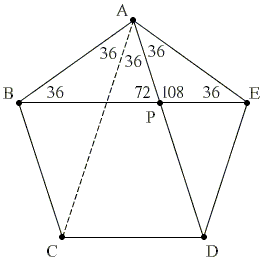cos 36°
The purpose of this page is to establish that
\(\cos (36^{\circ}) = \displaystyle\frac{(1 + \sqrt{5})}{4}\).
It's a good exercise in trigonometry that was also useful in solving a curious sangaku problem.
We start with a regular pentagon. As every regular polygon, this one too is cyclic. So that we may assume its vertices lie on a circle and sides and diagonals form inscribed angles.

It follows that every angle of the regular pentagon equals \(108^{\circ}\). Inscribed \(\angle CAD\) is half of the central angle \(72^{\circ}=\displaystyle\frac{360^{\circ}}{5}\), i.e.
\(\angle CAD = 36^{\circ}\).
By symmetry \(\angle BAC = \angle DAE\) implying that these two are also \(36^{\circ}\). (Note in passing that we just proved that angle \(108^{\circ}\) is trisectable.) Other angles designated in the diagram are also easily calculated.
As far as linear segments are concerned, we may observe that triangles \(ABP\), \(ABE\), \(AEP\) are isosceles, in particular,
\(AB = BP\),
\(AB = AE\),
\(AP = EP\).
Triangles ABE and AEP are also similar, in particular
\(BE / AB = AE / EP\), or
\(BE\times EP = AB^{2}\), i.e.
\((BP + EP)\times EP = AB^{2}\), and lastly,
\((AB + EP)\times EP = AB^{2}\).
For the ratio \(x = AB/EP\) we have the equation
\(x + 1 = x^{2}\),
with one positive solution \(x = \phi\), the golden ratio. (These calculations were in fact performed to justify a construction of regular pentagon. We return to them here in order to facilitate the references.)
In \(\triangle AEP\), \(AE = AB\) and \(EP\) is one of the sides such that \(AE/EP = \phi \). Drop a perpendicular from \(P\) to \(AE\) to obtain two right triangles. Then say,
\(\cos (\angle AEP) = (AE/2)/EP = (AE/EP)/2 = \phi /2\).
But \(\angle AEP = 36^{\circ}\) and we get the desired result.
Using \(\cos (36^{\circ}) = (1 + \sqrt{5})/4\) we can find
\(\cos (18^{\circ})=\sqrt{2(5+\sqrt{5})}/4\)
from \(\cos 2\alpha = 2\cos ^{2}\alpha - 1\) and then
\(\sin (18^{\circ})=\sqrt{2(3-\sqrt{5})}/4\)
from \(\cos ^{2}\alpha + \sin ^{2}\alpha = 1\). Now, it may be hard to believe but this expression simplifies to
\(\sin (18^{\circ}) = (\sqrt{5} - 1)/4\),
which is immediately verified by squaring the two expressions. Also
\(\sin (36^{\circ})=\sqrt{2(5-\sqrt{5})}/4\)
from \(\sin 2\alpha = 2\space \sin \alpha \space \cos \alpha\).
We can easily find \(\cos (72^{\circ})\) from \(\cos 2\alpha = 2\cos ^{2}\alpha - 1\):
\( \begin{align} \cos (72^{\circ}) &= 2\cos ^{2}(36^{\circ}) - 1 \\ &= 2[(\sqrt{5} + 1) / 4]^{2} - 1 \\ &= (6 + 2\sqrt{5} / 8 - 1 \\ &= (3 + \sqrt{5} / 4 - 1 \\ &= (\sqrt{5} - 1) / 4. \end{align} \)
This is of course equal to \(\sin (18^{\circ})\) as might have been expected from the general formula, \(\sin \alpha = \cos (90^{\circ} - \alpha )\).
And, of course,
\(\sin (72^{\circ})=\sqrt{2(5+\sqrt{5})}/4\)
because \(\sin (72^{\circ}) = \cos (18^{\circ})\).
Finally, let's compute $\sin 54^{\circ}:\;$
$\displaystyle\begin{align} \sin 54^{\circ} &= \sin 36^{\circ}\cos 18^{\circ}+\cos 36^{\circ}\sin 18^{\circ}\\ &= \displaystyle\frac{\sqrt{2(5-\sqrt{5})}}{4}\cdot \displaystyle\frac{\sqrt{2(5+\sqrt{5})}}{4} + \displaystyle\frac{1 + \sqrt{5}}{4}\cdot\displaystyle\frac{\sqrt{5}-1}{4}\\ &=\displaystyle\frac{\sqrt{5}+1}{4}, \end{align}$
as expected since $\sin 54^{\circ}=\cos 36^{\circ}.$
Trigonometry
- What Is Trigonometry?
- Addition and Subtraction Formulas for Sine and Cosine
- The Law of Cosines (Cosine Rule)
- Cosine of 36 degrees
- Tangent of 22.5o - Proof Wthout Words
- Sine and Cosine of 15 Degrees Angle
- Sine, Cosine, and Ptolemy's Theorem
- arctan(1) + arctan(2) + arctan(3) = π
- Trigonometry by Watching
- arctan(1/2) + arctan(1/3) = arctan(1)
- Morley's Miracle
- Napoleon's Theorem
- A Trigonometric Solution to a Difficult Sangaku Problem
- Trigonometric Form of Complex Numbers
- Derivatives of Sine and Cosine
- ΔABC is right iff sin²A + sin²B + sin²C = 2
- Advanced Identities
- Hunting Right Angles
- Point on Bisector in Right Angle
- Trigonometric Identities with Arctangents
- The Concurrency of the Altitudes in a Triangle - Trigonometric Proof
- Butterfly Trigonometry
- Binet's Formula with Cosines
- Another Face and Proof of a Trigonometric Identity
- cos/sin inequality
- On the Intersection of kx and |sin(x)|
- Cevians And Semicircles
- Double and Half Angle Formulas
- A Nice Trig Formula
- Another Golden Ratio in Semicircle
- Leo Giugiuc's Trigonometric Lemma
- Another Property of Points on Incircle
- Much from Little
- The Law of Cosines and the Law of Sines Are Equivalent
- Wonderful Trigonometry In Equilateral Triangle
- A Trigonometric Observation in Right Triangle
- A Quick Proof of cos(pi/7)cos(2.pi/7)cos(3.pi/7)=1/8
Fibonacci Numbers
- Ceva's Theorem: A Matter of Appreciation
- When the Counting Gets Tough, the Tough Count on Mathematics
- I. Sharygin's Problem of Criminal Ministers
- Single Pile Games
- Take-Away Games
- Number 8 Is Interesting
- Curry's Paradox
- A Problem in Checker-Jumping
- Fibonacci's Quickies
- Fibonacci Numbers in Equilateral Triangle
- Binet's Formula by Inducion
- Binet's Formula via Generating Functions
- Generating Functions from Recurrences
- Cassini's Identity
- Fibonacci Idendtities with Matrices
- GCD of Fibonacci Numbers
- Binet's Formula with Cosines
- Lame's Theorem - First Application of Fibonacci Numbers
|Contact| |Front page| |Contents| |Geometry|
Copyright © 1996-2018 Alexander Bogomolny73603390
